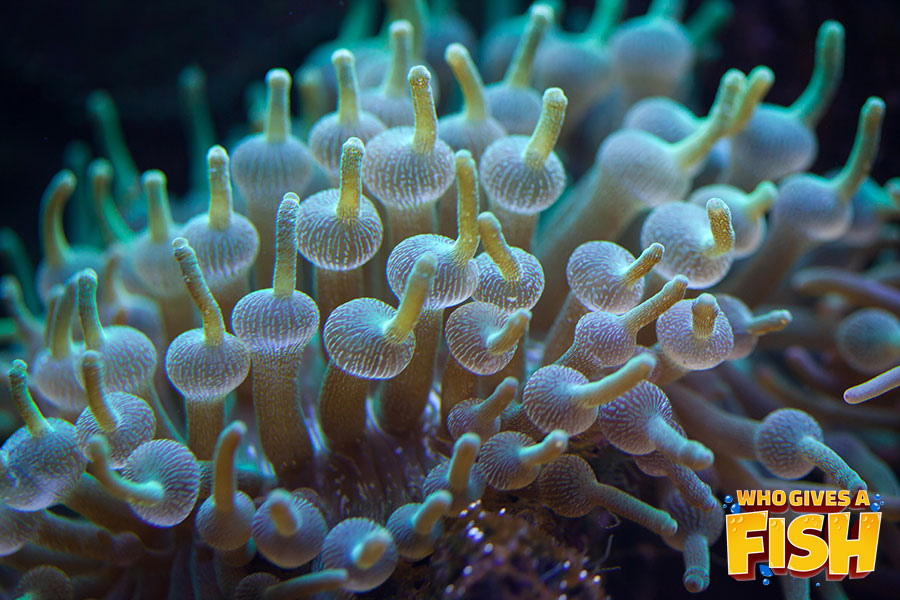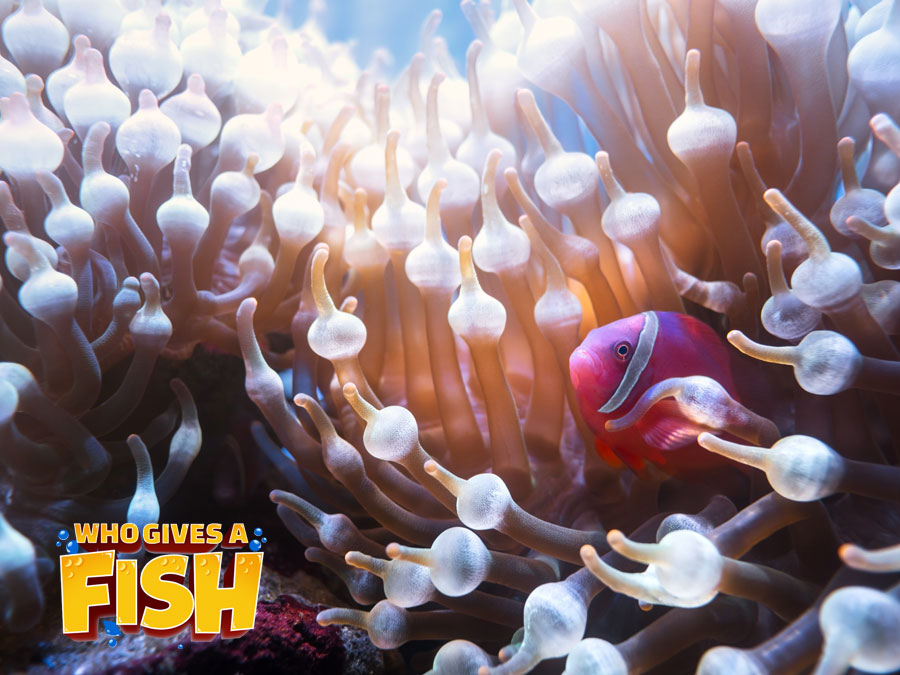Bubble Tip Anemone
The Bubble Tip Anemone, Entacmaea quadricolor, is without a doubt one of the most popular anemones in the home aquarium. It is also one of the most popular anemones for hosting Clownfish. These Anemones are best suited for bigger aquariums as they are well known for wandering around the aquarium causing problems. Having the correct conditions in your aquarium will allow you to showcase some beautiful, long lived bubble tips in an array of colors.
- Experience Level: Intermediate
- Hardiness: Moderate
- Minimum Tank Size: 50 gal (190 L)
- Lighting Needs: Strong lighting
- Temperature: 72° – 83° F (22.2° – 28° C)
- Gravity: 1.023 – 1.025
Table of Contents
Introduction
Aquarium Setup
Difficulty
Feeding
Breeding
Social
The Bubble Tip is well known for hosting Clownfish and will be accepted by most of the Clown Fish species. Bubble Tips are known for hosting 13 different types of Clownfish in the wild. The only other Anemone to be known to do this is the Sebae Anemone, Heteractis crispa.
In the ocean, Bubble Tip anemones will be most commonly found in more shallow water down to depths of around 130 feet (40m). Depending on where they are found in the wild, there will be two variations of it. The smaller Bubble Tip anemones will be found in large colonies in shallower water with the larger variations being found much deeper and being solitary. Each variation will play host to specific species of Clownfish living in the same area, in the same depths.
Bubble Tips have grown up to 12 inches (30 cm). They are generally found to be bluish-green, green, tan, brown, creamy pink, brick red and red. There is also a variation of a rosy color that has led to a common name Rose Bubble Tip Anemone. These have been well bred in captivity with the right conditions. In the wild, some anemones have been known to live hundreds of years and some in captivity have lived as long as 80 years.
The Bubble Tips have pedal columns, with a sticky foot that they use to stick themselves to on different surfaces in the wild and in the home aquarium. This foot will be used to help them move around when conditions are not favorable. Once they are comfortable, they will flare themselves out over the rocks around them and even corals that are close to them. This anemone has pedal columns which are a brown color and rows of verrucae and small bulges that have stinging cells on them. These little bumps can be yellow, orange or white and may also have lines, flicks and spots on them.
The tentacles found on the bubble tip surround the oral disc, that has a mouth right in the center. These tentacles can be bulbous in shape, often with a pear shape to them or smooth and tapered. Scientists are still unsure what causes the “bulbous” ends that give it this shape. The mouth in the center should be closed tightly and will only open when its hungry which will have an oval look. A wide gaping mouth is a big warming sign that something is wrong with the anemone.
Aquarium Setup
A typical reef setup is required for keeping a Bubble Tip anemone. Specimens that are larger than 12 inches, should be kept in no smaller than a 100-gallon tank that has 9-12 months of establishment. 30 gallons is the minimum size for small 2-inch juveniles, 50 gallons for a 4-inch specimen and 75 gallons for specimens 6-8 inches. Nano tanks are not ideal for these as water quality can be hard to maintain for them, as well as their fast growth rates.
The Bubble Tip Anemone will bury itself into nooks and crannies in the rocks. If the anemone is on the sand in your tank, place something on the bottom like coral branches for it to attach itself too. Moderate to high strength lighting is required for healthy anemones, which does include the use of LED lighting. If the lighting is not ideal for them then will get up and move higher to obtain more lighting. They will tolerate a low-moderate water current but won’t enjoy anything stronger than this. Water currents can be either turbulent or one directional. A good quality, functional skimmer is very necessary.
Unlike other corals, this Anemone will get up and move after you have placed it to find its own home. Once they find somewhere they like, they will sit and settle in this spot. However, many of these anemones will even go wandering despite having an ideal location and not being stressed. When keeping anemones, you need to ensure your pumps and skimmers are covered as anemones are known to get caught up and diced up after wondering.
Bubble Tip Coral Aquarium and Parameter Checklist
- Minimum Tank Size: 50 gal (190 L)
- Lighting Needs: Strong lighting
- Temperature: 72° – 83° F (22.2° – 28° C)
- Specific gravity: 1.023 – 1.025
- Alkalinity Levels: 3.5 – 4.8 MEQ/L (8 – 11 dKh)
- Calcium: 380 – 450 ppm
- Phosphates: 0 (Avoid Phosphates)
- Magnesium Levels: 1250 – 1350
- Strontium Levels: 5 – 15
- Water Movement: Moderate
- Tank Region: Bottom to Mid
The Bubble Tip Anemone hosting a Maroon Clownfish
Difficulty
The Bubble Tip Anemone are generally easy to care for as long as there is decent lighting, flow and ample rocks available for them in the reef tank. In addition, if you plan on placing an anemone in a newly established tank, you will likely run into problems. Established reef tank systems at least 8 months are recommended to ensure a stable environment is able to accommodate the Anemones crucial requirements.
Feeding
The Bubble Tip Anemone is carnivorous but are well developed to utilize other nutritional alternatives. Most of their daily nutrition come from zooxanthellae, symbiotic algae that lives within the anemones tissues. They also have nematocysts which are venomous cells that are found in their tentacles which are used to catch prey. They will often consume waste from Clownfish and absorb nutrients from the water around them. Quite often the Clown fish that they host will bring them food as part of their relationship, although not always.
Bubble Tip Anemones require feeding 3-4 times a week. When they are young or sick, they will require daily feeds of chopped food as they either don’t have or have lost their zooxanthellae. You can offer your clown fish a larger piece of food that they may take down to the anemone where it will be shared.
Breeding
Anemones are able to multiply both sexually and asexually. One method is by using fission, which is when the Anemone will split in half from its foot or mouth and will form a clone of itself. The clone is in fact its own animal, similar to that of twins. There is at least one pair of Bubble Tips that have been reported to mouth brood, which is when the anemone will brood juvenile anemones within its oral cavity and then release these into the water. This process will supply those embryos their own zooxanthellae, crucial for survival. When they are released, the planula or embryos will float before connecting and starting out as a fully formed anemone. As they have Zooxanthellae, they could possibly travel for a while without needing to feed.
The Bubble Tip anemone has been bred in captivity well. Some people have even propagated their anemones, which does require a very clean system despite it being easy to do. Some anemones can get torn for different reasons. If this does happen, simply leave them alone and maintain water changes, they will heal fine on their own.
If you are to propagate your anemone, ensure the following steps are adhered to for success:
- Ensure your anemone is in good health before attempting this.
- Perform a large water change prior to, and use this water for a recovery tank the next day if needed.
- Place the anemone on a damp, non-slippery and clean surface with its mouth facing upwards.
- Using sharp scissors or a scalpel, cut the anemone right down the center, through the mouth to create 2 halves – if it is a large anemone you can do this again and make 4 pieces.
- If its attached to a rock, you can just cut the anemone in the center of the mouth on one side, long ways with the length of the mouth, and hope that the anemone will finish the split by itself.
- Then place your new individual anemone pieces into a medium sized “recovery” tank, using the same water from your main tank to ensure the parameters are the same.
- Do small 20% water changes a few days after this procedure.
- Place some rocks in the tank for them to re-attach themselves to.
If your main tank is over 100 gallons, it is recommended to do a 30-40% water change before cutting, as this will help with the recovery. Once cut, place them back onto their favorite rock as this will help encourage them to reattach to it. Ensure you wash your hands after this if you didn’t wear gloves.Within a few days, your anemone will have wrapped around itself and begun healing. Do not feed any of them and ensure to keep clown fish away.




Social
These anemones are can be considered semi-aggressive being able to move around your tank and sting other corals in its path. They should be added to your reef tank and settled in before adding further corals.
The Anemone should be at least 3 time larger than a potential Clownfish guest if you are intending that it host one.
Back to top